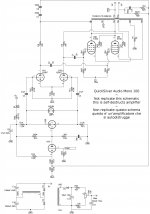They are fixed bias, and either there is a bad coupling cap, bad tube or related component failure. The ones I have worked on did not have cathode feedback windings, but that was long ago.
Perhaps a little more detail and a schematic would help us to help you solve the problem.
Perhaps a little more detail and a schematic would help us to help you solve the problem.
This is the output stage...problem is when bias voltage 60 to 70 volt is applied to output tubes one of the output tube cathode ma is half of the other tube the bias voltage is the same on both grids , tried 6 output tubes and the result same also replaced coupling cap and resistors nothing change.
Attachments
Measure the dc resistance of each half of the cathode winding, if the DCR is different the voltage developed across that DCR will be different too.
Look at the other amplifier, do they match?
The cathode winding is an integral part of the output stage loading, if there is a short in that winding the transformer must be repaired (less likely) or replaced (more likely). Assuming that the transformer is actually bad simply disconnecting leaves the shorted winding in place and may substantially change the load reflected to the output tubes even if it is not shorted. DC winding resistance may not match that closely and possibly nothing more than winding technique is the culprit here if you are fortunate.
Your RS multimeter is probably not going to tell you the truth wrt winding resistances either. Measuring low resistances accurately generally requires a meter with 4 wire (kelvin) resistance measurement capability.
An approximation can be made by measuring the meter lead resistance after doing as much as possible to minimize it and subtracting that from the actual resistance reading. It is likely that cheap meter won't do this well either.
Look at the other amplifier, do they match?
The cathode winding is an integral part of the output stage loading, if there is a short in that winding the transformer must be repaired (less likely) or replaced (more likely). Assuming that the transformer is actually bad simply disconnecting leaves the shorted winding in place and may substantially change the load reflected to the output tubes even if it is not shorted. DC winding resistance may not match that closely and possibly nothing more than winding technique is the culprit here if you are fortunate.
Your RS multimeter is probably not going to tell you the truth wrt winding resistances either. Measuring low resistances accurately generally requires a meter with 4 wire (kelvin) resistance measurement capability.
An approximation can be made by measuring the meter lead resistance after doing as much as possible to minimize it and subtracting that from the actual resistance reading. It is likely that cheap meter won't do this well either.
I got this amplifier from a friend who is a Mac tube fanatic he didn't like the Quicksilver cause didn't had Mac looks , he always polish his amplifier with Brasso ... too much Brasso most of it ended up in the tube sockets .. next he always forcing the tube in the sockets he ended cracking pin 7 on the output tube.
- Status
- This old topic is closed. If you want to reopen this topic, contact a moderator using the "Report Post" button.
- Home
- Amplifiers
- Tubes / Valves
- Quicksilver 60Watt KT88 amp
